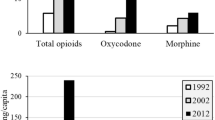Abstract
This study investigates the possible involvement of opioid receptors in the action of a variety of anticonvulsant agents. The opioid antagonist naloxone (0.3, 1 mg/kg IP) and the selective μ-opioid antagonist cyprodime (3 mg/kg IP) significantly inhibited the increase in electroshock seizure threshold induced by phenytoin (3 mg/kg IP) in mice. The anticonvulsant effects of ethanol (1 g/kg IP) were also significantly antagonised by naloxone (1 mg/kg IP) but not by a 0.3 mg/kg IP dose or by cyprodime (3 mg/kg IP). The results with naloxone were confirmed using higher doses of phenytoin (10 mg/kg IP) and ethanol (1.5 g/kg IP). In contrast to the above findings, naloxone (0.3, 1 mg/kg IP) had no effect on the increase in seizure threshold induced by sodium valproate (200 mg/kg IP) or dizocilpine (MK801, 0.5 mg/kg IP) and paradoxically potentiated the increase in seizure threshold produced by phenobarbitone (15 mg/kg IP); carbamazepine (10 mg/kg IP) and the benzodiazepine agonist loprazolam (1 mg/kg IP), clearly differentiating these compounds from phenytoin and ethanol. These findings suggest that the anticonvulsant effects of phenytoin and ethanol (as assessed by their ability to prevent tonic hindlimb extension in the mouse electroshock model) may be mediated, at least in part, by the release of endogenous opioids and subsequent activation of opioid receptors (μ, in the case of phenytoin, but non-μ, in the case of ethanol) although direct activity at opioid receptors cannot be precluded.
Similar content being viewed by others
References
Clineschmidt BV, Martin GE, Bunting PR (1982) Anticonvulsant activity of (±)-methy 1–10, 11-dihydro-5H-dibenzo (a,d) cyclohepten-5, 10-imine (MK-801) a substance with potent anticonvulsant, central sympathomimetic, and apparent anxiolytic properties. Drug Dev Res 2:123–134
Fariello RG, Forchetti CM, Fisher RS (1991) GABAergic function in relation to seizure phenomena. In: Fisher RS, Coyle JT (eds) Neurotransmitters and epilepsy. Wiley, New York, pp 77–93
Finney DJ (1971) Probit analysis. University Press, Cambridge
Frenk H (1983) Pro- and anticonvulsant actions of morphine and the endogenous opioids: involvement and interactions of multiple opiate and non-opiate systems. Brain Res Rev 6:197–210
Frey H-H (1987) Interactions between morphine-like analgesics and anticonvulsant drugs. Pharmacol Toxicol 60:210–213
Jackson HC, Nutt DJ (1991) Differential effects of selective μ-, κ- and δ-opioid antagonists on electroshock seizure threshold in mice, Psychopharmacology 103:380–383
Johns TG, Piper DC, James GWL (1979) The pharmacological profile of a potential hypnotic compound RU 31158. Arch Int Pharmacodyn 240:53–65
Katz RJ, Schmaltz K (1979) Facilitation of opiate- and enkephalin-induced motor activity in the mouse by phenytoin sodium and carbamazepine. Psychopharmacology 65:65–68
Levy RH, Dreifuss FE, Mattson RH, Meldrum BS, Penry JK (1989) Antiepileptic drugs, edn 3. Raven, New York
Litchfield JT, Wilcoxon F (1949) A simplified method of evaluating dose-effect experiments. J Pharmacol Exp Ther 96:99–113
Nutt DJ, Lister RG (1987) The effect of the imidazodiazepine Ro 15-4513 on the anticonvulsant effects of diazepam, sodium pentobarbital and ethanol. Brain Res 413:193–196
Rogawski MA, Porter RJ (1990) Antiepileptic drugs: pharmacological mechanisms and clinical efficacy with consideration of promising developmental stage compounds, Pharmacol Rev 42:223–286
Schmidhammer H, Burkard WP, Eggstein-Aeppli L, Smith CFC (1989) Synthesis and biological evaluation of 14-alkoxymorphinans. 2. (−)-N-(cyclopropylmethyl)-4, 14-dimethoxymorphinan-6-one, a selective μ opioid receptor antagonist. J Med Chem 32:418–421
Schmutz M, Portet C, Jeker A, Klebs K, Vassout A, Allgeier H, Heckendorn R, Fagg GE, Olpe H-R, Van Riezen H (1990) The competitive NMDA receptor antagonists CGP 37849 and CGP 39551 are potent orally-active anticonvulsants in rodents. Naunyn-Schmiedeberg's Arch Pharmacol 342:61–66
Schulz R, Wuster M, Duka T, Herz A (1980) Acute and chronic ethanol treatment changes endorphin levels in brain and pituitary. Psychopharmacology 68:221–227
Smith SE, Durmuller N, Meldrum BS (1991) The non-N-methyl-d-aspartate receptor antagonists, GYKI 52466 and NBQX are anticonvulsant in two animal models of reflex epilepsy. Eur J Pharmacol 201:179–183
Snead OC, Simonato M, (1991) Opioid peptides and seizures. In: Fisher RS, Coyle JT (eds) Neurotransmitters and epilepsy. Wiley, New York, pp 181–200
Swedberg MDB, Jacobsen P, Honore T (1990) NBQX, (2,3-dihydroxy-6-nitro-7-sulfamoyl-benzo (f) quinoxaline): anticonvulsant effects in mice. Soc Neurosci Abstr 16:1182
Swinyard EA (1972) Electrically induced convulsions. In: Purpura DP, Penry JK, Tower DB, Woodbury DM, Walter RD (eds) Experimental models of epilepsy — a manual for the laboratory worker. Raven, New York, pp 433–458
Swinyard EA, Woodhead JH, White HS, Franklin MR (1989) Experimental selection, quantification, and evaluation of anticonvulsants. In: Levy R, Mattson R, Meldrum B, Penry JK, Dreifuss FE (eds) Antiepileptic drugs, edn 3. Raven, New York, pp 85–102
Tabakoff B, Hoffman PL (1983) Alcohol interactions with brain opiate receptors. Life Sci 32:197–204
Tortella FC, Long JB (1988) Characterization of opioid peptide-like anticonvulsant activity in rat cerebrospinal fluid. Brain Res 456:139–146
Tortella FC, Robles L, Holaday JW (1986) U50, 488, a highly selective kappa opioid: anticonvulsant profile in rats. J Pharmacol Exp Ther 237:49–53
Tortella FC, Robles L, Echevarria E, Hunter JC, Hughes J (1990) PD117302, a selective non-peptide opioid kappa agonist, protects against NMDA and maximal electroshock convulsions in rats. Life Sci 46:PL-1–PL-7
Von Voigtlander PF, Lahti RA, Ludens JH (1983) U-50, 488: a selective and structurally novel non-mu (kappa) opioid agonist. J Pharmacol Exp Ther 224:7–12
Weiss F, Koob GF (1991) The neuropharmacology of ethanol self-administration. In: Meyer RE, Koob GF, Lewis MJ, Paul SM (eds) Neuropharmacology of ethanol. Birkhauser, Boston, pp 125–162
Wong EHF, Kemp JA, Priestley T, Knight AR, Woodruff GN, Iversen LL (1986) The anticonvulsant MK-801 is a potent N-methyl-d-aspartate antagonist. Proc Natl Acad Sci USA 83:7104–7108
Author information
Authors and Affiliations
Rights and permissions
About this article
Cite this article
Jackson, H.C., Nutt, D.J. Investigation of the involvement of opioid receptors in the action of anticonvulsants. Psychopharmacology 111, 486–490 (1993). https://doi.org/10.1007/BF02253540
Received:
Revised:
Issue Date:
DOI: https://doi.org/10.1007/BF02253540




